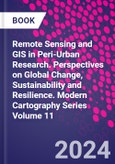Remote Sensing and GIS in Peri-Urban Research: Perspectives on Global Change, Sustainability and Resilience, Eleventh Edition provides the most recent methods and techniques, incorporating geoinformatics-based practices to map, evaluate, and model urban landscape attributes and changes. The book provides theory, methodology, and future perspectives of remote sensing and GIS techniques applied to peri-urban modelling, analysis and sustainability through the use of spatio-temporal geospatial datasets. It also includes case studies of real-world data sets, with applicable algorithms, techniques and methods for study.
This will be a useful reference for researchers and academics in remote sensing, GIS, and spatial analysis, and environmental or urban scientists wanting to implement remote sensing technologies in their research.
Please Note: This is an On Demand product, delivery may take up to 11 working days after payment has been received.
Table of Contents
Section I: Peri-urban interfaces and global change1. GIS application on mapping and identification of peri-urban areas
2. Urban and peri-urban land use dynamics
3. Remote sensing and GIS on urban environmental change
4. Landscape ecological analysis
5. Urban growth and fringe development
6. Rural-urban linkages
Section II: Urban and peri-urban land use dynamics
7. Monitoring, mapping, and assessing the urban spatial patterns
8. Urban form, structure and landscape function
9. Land transformation and peri-urban land use changes
10. The Environmental and Social Impacts of Peri-Urban agriculture
11. Peri-urban wetland and ecological degradation
Section III: Peri-urban interface and ecosystems services
12. Peri urban water supply and sanitation
13. Peri-Urban Ecosystems and Societies
14. Horticulture and vegetable farming at the Peri-Urban Interface
15. Livelihoods from Dairying Enterprises in the Peri-Urban
16. Waste-Fed Fisheries in Peri-Urban
17. Livelihoods of Pastoralists in the Peri-Urban Interface
18. Peri-urban ecosystems service and Carbon sequestration
Section IV: The Peri-Urban interface: planning and management
19. Peri-Urban growth in the megacities of Developing Countries
20. Environmental Change and Rural-Urban Interactions
21. Policies, Strategies and the Peri-Urban Interface
22. Environmental Management in urban and Peri-Urban areas
23. Peri-urbanisation & climate-environment interactions








